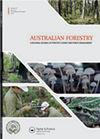Dendroecology: principles and practice
IF 1.2
4区 农林科学
Q3 FORESTRY
引用次数: 0
Abstract
Trees are long-lived organisms that are influenced by both their biotic and abiotic environments. Dendrochronology can be characterised as the study of trees to provide information about past environments. Dendrochronologists have been using tree rings to understand how the environment has varied at annual, decadal and centennial scales for almost a century. Dendrochronology has provided the foundation for insights into climate variability, forest stand development patterns, and the impacts of fires, insects, windstorms and other disturbances. The science of tree rings has advanced rapidly and become diversified over the past half-century. This has included, but not been limited to, complex timeseries analyses, isotope and wood properties analyses, processbased modelling of xylogenesis, and ecosystem-level experiments. As such, the arrival of a new book on the study of tree rings is always of interest. In Dendroecology: principles and practice, Richard Phipps and Thomas Yanosky provide an introduction to the dendrochronological techniques available to study environmental history, as recorded in trees. The book begins with a very brief overview of the history of dendrochronology (in the US only), tree structure and different types of wood structure. It then outlines the basics of sample collection and issues to consider in the field, followed by a description of the crucial processes of crossdating and the standardisation of tree-ring series. Chapters 4–7 present information about, and examples of, how tree rings can assist in understanding past environmental events. Finally, Chapter 8 briefly discusses the use of tree rings in climate studies. The authors lean almost exclusively on their experience with the angiosperm species of the eastern US, and they provide a number of interesting anecdotal studies to demonstrate the application of basic principles. They especially emphasise the use of basal area increment (BAI) in their studies. Overall, I found the book disappointing for several reasons. First, given the title, I expected a stronger emphasis on the ecological aspects of dendrochronology and the integration of a far broader range of studies conducted in North America, South America and Asia that have emerged in the past 20–30 years. Second, much of the information in the book is outdated, and in some instances it is dangerously primitive. For example, any discussion of standardisation—the statistical process used to remove non-climatic information from tree rings— should acknowledge regional curve standardisation (and its variations) and signal-free standardisation, two major developments in the quantitative analysis of tree-ring time series since the mid-1990s. The seminal works of Keith Briffa, Tom Melvin, Jan Esper and Ed Cook (e.g. Cook & Kariukstis 1990; Melvin & Briffa 2008; Esper et al. 2010; Briffa et al. 2013) are easily accessible, and yet reference to them is almost entirely missing from this volume. Several other commonly used standardisation methods may be more appropriate to use in certain circumstances than that advanced by the authors, but the authors make no mention of these. Further, key technical issues with standardisation, such as the use of residuals rather than ratios (the authors only point to the use of ratios for standardisation), were raised in the late 1990s by Cook and Peters (1997). Anyone attempting to work with tree-ring time series needs to be aware of these issues. In addition to omitting key advances, the authors introduce opacity to basic terms such as standardisation and smoothing that have different purposes. This is likely to confuse readers, especiall students of dendrochronology. A further case in point concerning the dated nature of the book is its reference to Henri Grissino-Mayer’s ultimate tree-ring webpages, which have been defunct for some time. Third, the writing is repetitive and confusing. For example, BAI, and its calculation, is ‘introduced’ at least three times. In general, the text wanders back and forth throughout the book, making a clear reading of the important points difficult, especially for a dendrochronological novice. Extensive use of phases such as, ‘. . . as discussed in the previous section . . .’ or ‘. . . as will be discussed in the next section . . .’ followed by a re-iteration of what was/is discussed above/below, muddy the text. An odd quirk is the ‘selected references’ at the end of each chapter and little in-text referencing, which makes it difficult for a reader to follow up on any specific points of interest. Finally, an explicit statement about the geographical context of the book would have been useful. With the dominance in the literature of dendroecological studies using coniferous species, the authors could have leveraged their experience in angiosperm forests in the eastern US to their advantage. Had they done so, and made a much more rigorous effort to discuss a broader range of ecological studies, this book would have represented a valuable contribution to the literature. However, novice dendrochronologists would be better directed to Jim Speer’s Fundamentals of tree-ring research (Speers 2010) as an introductory text. Students who want a more detailed and extensive reference to the types of environmental disturbance signals that may be recorded in trees could consult Fritz Schweingruber’s Tree rings and environment dendroecology (Schweingruber 1996). For those interested in the latest advances—conceptual, technical, and geographical—in dendroecology, the recent Dendroecology: tree-ring analyses applied to ecological studies, edited by Mariano Amoroso and colleagues (2017), would be a much better point of departure.树木生态学原理与实践
树木是长寿命的生物体,受其生物和非生物环境的影响。树木年代学的特点是通过研究树木来提供有关过去环境的信息。近一个世纪以来,树木年轮学家一直在利用树木年轮来了解环境在年、年、百年尺度上的变化。树木年代学为深入了解气候变化、林分发展模式以及火灾、昆虫、风暴和其他干扰的影响提供了基础。在过去的半个世纪里,树木年轮科学发展迅速,变得多样化。这包括,但不限于,复杂的时间序列分析,同位素和木材特性分析,基于过程的木质学建模,以及生态系统水平的实验。因此,一本关于树木年轮研究的新书的问世总是引起人们的兴趣。在《树木生态学:原理与实践》一书中,理查德·菲普斯和托马斯·扬诺斯基介绍了用于研究树木记录的环境历史的树木年代学技术。这本书开始与树木年代学的历史(仅在美国),树木结构和不同类型的木结构的一个非常简短的概述。然后概述了样品收集的基础知识和该领域需要考虑的问题,随后描述了交叉定年的关键过程和树木年轮系列的标准化。第4-7章提供了关于树木年轮如何帮助理解过去环境事件的信息和例子。最后,第8章简要讨论了树木年轮在气候研究中的应用。作者几乎完全依靠他们在美国东部的被子植物物种方面的经验,他们提供了许多有趣的轶事研究来证明基本原理的应用。他们在研究中特别强调基础面积增量(BAI)的使用。总的来说,我觉得这本书令人失望有几个原因。首先,考虑到这个标题,我希望能更强调树木年代学的生态方面,并整合过去20-30年来在北美、南美和亚洲开展的更广泛的研究。其次,书中的许多信息都过时了,在某些情况下,它是危险的原始。例如,任何关于标准化的讨论——用于从树木年轮中去除非气候信息的统计过程——都应该承认区域曲线标准化(及其变化)和无信号标准化,这是自20世纪90年代中期以来树木年轮时间序列定量分析的两个主要发展。Keith Briffa, Tom Melvin, Jan Esper和Ed Cook的开创性作品(例如Cook & Kariukstis 1990;Melvin & Briffa 2008;Esper et al. 2010;Briffa et al. 2013)很容易获得,但在本卷中几乎完全没有对它们的参考。在某些情况下,其他几种常用的标准化方法可能比作者提出的方法更适合使用,但作者没有提及这些方法。此外,Cook和Peters(1997)在20世纪90年代末提出了标准化的关键技术问题,例如使用残差而不是比率(作者只指出使用比率进行标准化)。任何试图处理树轮时间序列的人都需要意识到这些问题。除了省略关键的进展外,作者还对具有不同目的的基本术语(如标准化和平滑)引入了不透明性。这可能会让读者感到困惑,尤其是研究树木年代学的学生。关于这本书的年代性质的一个进一步的例子是它引用了亨利·格里森-迈耶的最终树轮网页,这些网页已经消失了一段时间。第三,文字重复,令人困惑。例如,BAI及其计算至少被“介绍”了三次。一般来说,文本在整本书中来回徘徊,使得清晰地阅读要点变得困难,特别是对于树木年代学的新手。广泛使用诸如“……正如前一节所讨论的……或……正如我们将在下一节讨论的那样……”,接着是对上面/下面讨论过的内容的重复,使文本变得模糊。一个奇怪的怪癖是每章末尾的“精选参考文献”和很少的文本参考文献,这使得读者很难跟上任何特定的兴趣点。最后,关于这本书的地理背景的明确陈述将是有用的。由于使用针叶物种进行树木生态学研究的文献占主导地位,作者可以利用他们在美国东部被子植物森林中的经验来发挥他们的优势。
本文章由计算机程序翻译,如有差异,请以英文原文为准。
求助全文
约1分钟内获得全文
求助全文
来源期刊

Australian Forestry
FORESTRY-
CiteScore
3.70
自引率
4.80%
发文量
15
审稿时长
>12 weeks
期刊介绍:
Australian Forestry is published by Taylor & Francis for the Institute of Foresters of Australia (IFA) for scientific, technical, and professional communication relating to forestry in the Asia Pacific.
 求助内容:
求助内容: 应助结果提醒方式:
应助结果提醒方式:


